driver seat adjustment FORD ESCAPE 2018 Owners Manual
[x] Cancel search | Manufacturer: FORD, Model Year: 2018, Model line: ESCAPE, Model: FORD ESCAPE 2018Pages: 517, PDF Size: 6.62 MB
Page 4 of 517
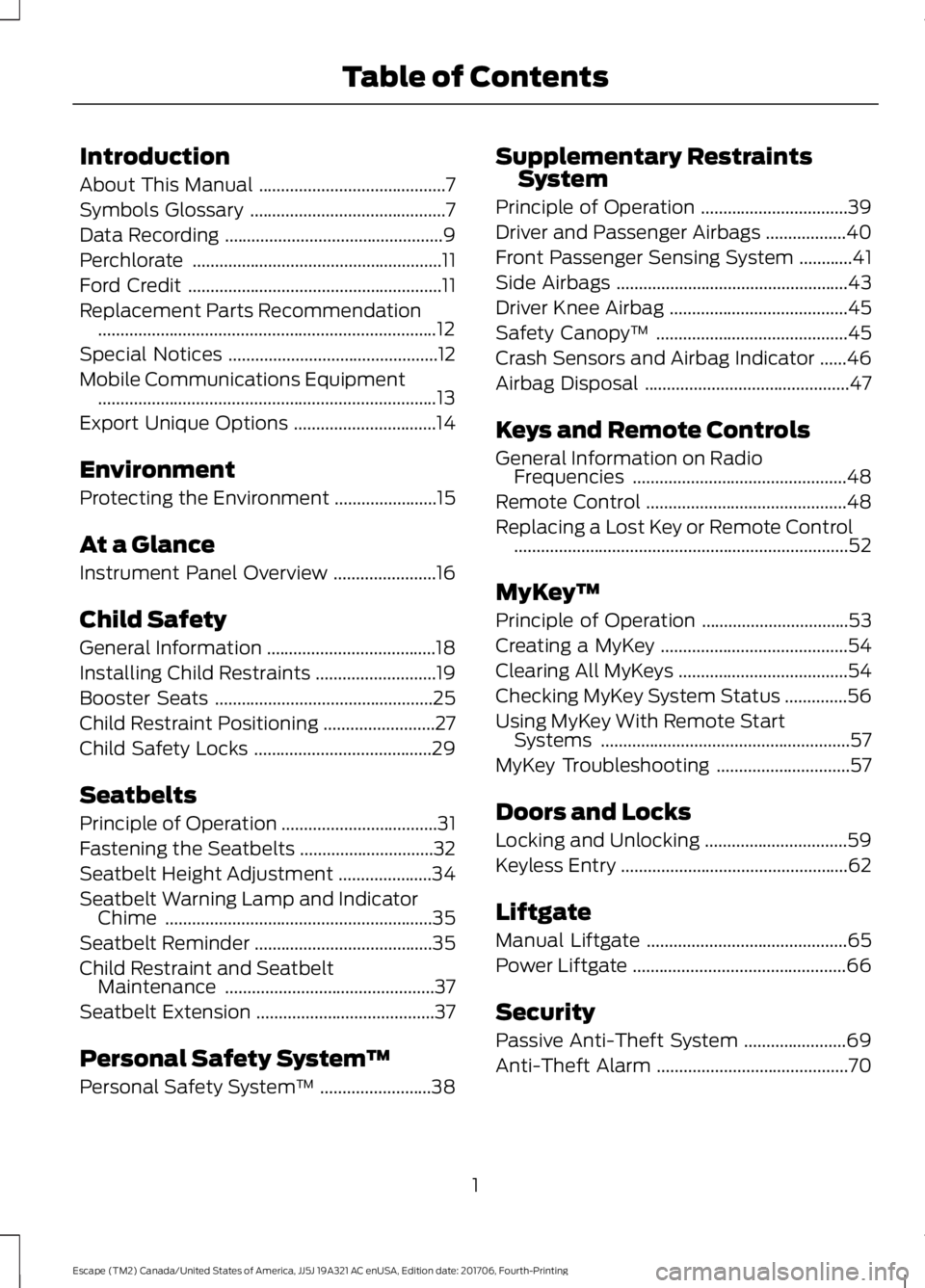
Introduction
About This Manual
..........................................7
Symbols Glossary ............................................
7
Data Recording .................................................
9
Perchlorate ........................................................
11
Ford Credit .........................................................
11
Replacement Parts Recommendation ........................................................................\
....
12
Special Notices ...............................................
12
Mobile Communications Equipment ........................................................................\
....
13
Export Unique Options ................................
14
Environment
Protecting the Environment .......................
15
At a Glance
Instrument Panel Overview .......................
16
Child Safety
General Information ......................................
18
Installing Child Restraints ...........................
19
Booster Seats .................................................
25
Child Restraint Positioning .........................
27
Child Safety Locks ........................................
29
Seatbelts
Principle of Operation ...................................
31
Fastening the Seatbelts ..............................
32
Seatbelt Height Adjustment .....................
34
Seatbelt Warning Lamp and Indicator Chime ............................................................
35
Seatbelt Reminder ........................................
35
Child Restraint and Seatbelt Maintenance ...............................................
37
Seatbelt Extension ........................................
37
Personal Safety System ™
Personal Safety System ™.........................
38 Supplementary Restraints
System
Principle of Operation .................................
39
Driver and Passenger Airbags ..................
40
Front Passenger Sensing System ............
41
Side Airbags ....................................................
43
Driver Knee Airbag ........................................
45
Safety Canopy ™...........................................
45
Crash Sensors and Airbag Indicator ......
46
Airbag Disposal ..............................................
47
Keys and Remote Controls
General Information on Radio Frequencies ................................................
48
Remote Control .............................................
48
Replacing a Lost Key or Remote Control ........................................................................\
...
52
MyKey ™
Principle of Operation .................................
53
Creating a MyKey ..........................................
54
Clearing All MyKeys ......................................
54
Checking MyKey System Status ..............
56
Using MyKey With Remote Start Systems ........................................................
57
MyKey Troubleshooting ..............................
57
Doors and Locks
Locking and Unlocking ................................
59
Keyless Entry ...................................................
62
Liftgate
Manual Liftgate .............................................
65
Power Liftgate ................................................
66
Security
Passive Anti-Theft System .......................
69
Anti-Theft Alarm ...........................................
70
1
Escape (TM2) Canada/United States of America, JJ5J 19A321 AC enUSA, Edition date: 201706, Fourth-Printing Table of Contents
Page 36 of 517
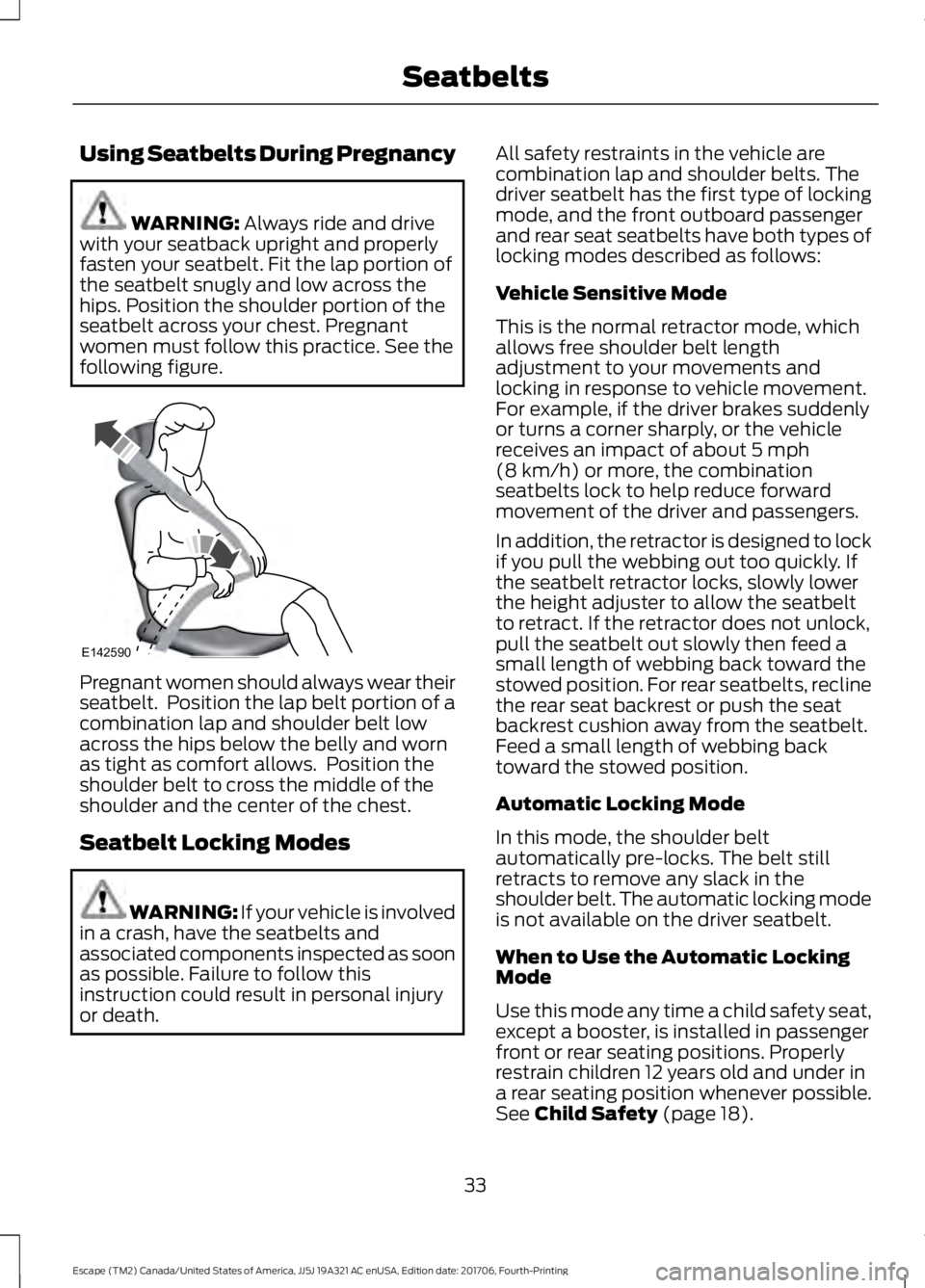
Using Seatbelts During Pregnancy
WARNING: Always ride and drive
with your seatback upright and properly
fasten your seatbelt. Fit the lap portion of
the seatbelt snugly and low across the
hips. Position the shoulder portion of the
seatbelt across your chest. Pregnant
women must follow this practice. See the
following figure. Pregnant women should always wear their
seatbelt. Position the lap belt portion of a
combination lap and shoulder belt low
across the hips below the belly and worn
as tight as comfort allows. Position the
shoulder belt to cross the middle of the
shoulder and the center of the chest.
Seatbelt Locking Modes
WARNING: If your vehicle is involved
in a crash, have the seatbelts and
associated components inspected as soon
as possible. Failure to follow this
instruction could result in personal injury
or death. All safety restraints in the vehicle are
combination lap and shoulder belts. The
driver seatbelt has the first type of locking
mode, and the front outboard passenger
and rear seat seatbelts have both types of
locking modes described as follows:
Vehicle Sensitive Mode
This is the normal retractor mode, which
allows free shoulder belt length
adjustment to your movements and
locking in response to vehicle movement.
For example, if the driver brakes suddenly
or turns a corner sharply, or the vehicle
receives an impact of about
5 mph
(8 km/h) or more, the combination
seatbelts lock to help reduce forward
movement of the driver and passengers.
In addition, the retractor is designed to lock
if you pull the webbing out too quickly. If
the seatbelt retractor locks, slowly lower
the height adjuster to allow the seatbelt
to retract. If the retractor does not unlock,
pull the seatbelt out slowly then feed a
small length of webbing back toward the
stowed position. For rear seatbelts, recline
the rear seat backrest or push the seat
backrest cushion away from the seatbelt.
Feed a small length of webbing back
toward the stowed position.
Automatic Locking Mode
In this mode, the shoulder belt
automatically pre-locks. The belt still
retracts to remove any slack in the
shoulder belt. The automatic locking mode
is not available on the driver seatbelt.
When to Use the Automatic Locking
Mode
Use this mode any time a child safety seat,
except a booster, is installed in passenger
front or rear seating positions. Properly
restrain children 12 years old and under in
a rear seating position whenever possible.
See
Child Safety (page 18).
33
Escape (TM2) Canada/United States of America, JJ5J 19A321 AC enUSA, Edition date: 201706, Fourth-Printing SeatbeltsE142590
Page 43 of 517
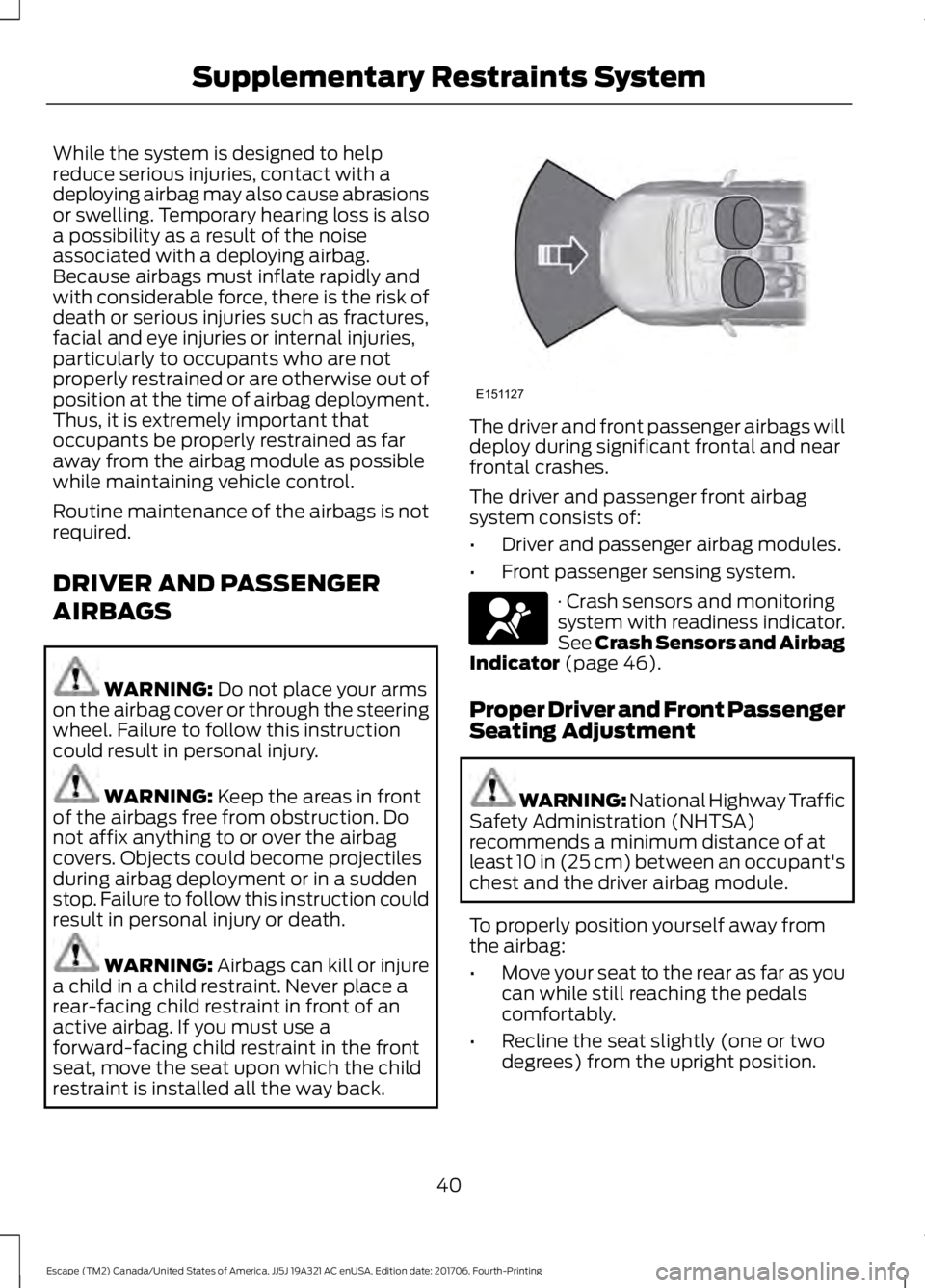
While the system is designed to help
reduce serious injuries, contact with a
deploying airbag may also cause abrasions
or swelling. Temporary hearing loss is also
a possibility as a result of the noise
associated with a deploying airbag.
Because airbags must inflate rapidly and
with considerable force, there is the risk of
death or serious injuries such as fractures,
facial and eye injuries or internal injuries,
particularly to occupants who are not
properly restrained or are otherwise out of
position at the time of airbag deployment.
Thus, it is extremely important that
occupants be properly restrained as far
away from the airbag module as possible
while maintaining vehicle control.
Routine maintenance of the airbags is not
required.
DRIVER AND PASSENGER
AIRBAGS
WARNING: Do not place your arms
on the airbag cover or through the steering
wheel. Failure to follow this instruction
could result in personal injury. WARNING:
Keep the areas in front
of the airbags free from obstruction. Do
not affix anything to or over the airbag
covers. Objects could become projectiles
during airbag deployment or in a sudden
stop. Failure to follow this instruction could
result in personal injury or death. WARNING:
Airbags can kill or injure
a child in a child restraint. Never place a
rear-facing child restraint in front of an
active airbag. If you must use a
forward-facing child restraint in the front
seat, move the seat upon which the child
restraint is installed all the way back. The driver and front passenger airbags will
deploy during significant frontal and near
frontal crashes.
The driver and passenger front airbag
system consists of:
•
Driver and passenger airbag modules.
• Front passenger sensing system. · Crash sensors and monitoring
system with readiness indicator.
See Crash Sensors and Airbag
Indicator
(page 46).
Proper Driver and Front Passenger
Seating Adjustment WARNING: National Highway Traffic
Safety Administration (NHTSA)
recommends a minimum distance of at
least
10 in (25 cm) between an occupant's
chest and the driver airbag module.
To properly position yourself away from
the airbag:
• Move your seat to the rear as far as you
can while still reaching the pedals
comfortably.
• Recline the seat slightly (one or two
degrees) from the upright position.
40
Escape (TM2) Canada/United States of America, JJ5J 19A321 AC enUSA, Edition date: 201706, Fourth-Printing Supplementary Restraints SystemE151127 E67017
Page 125 of 517
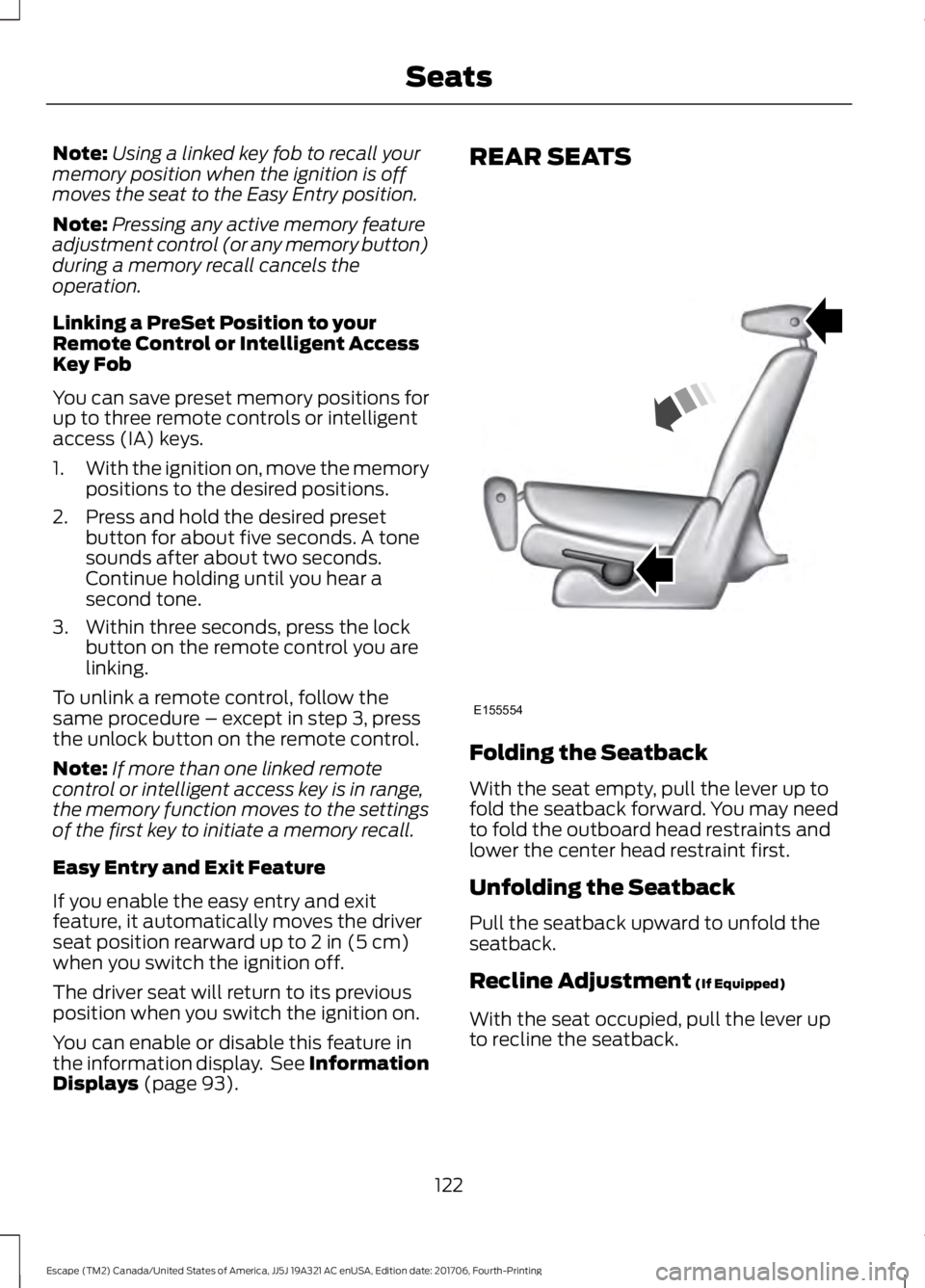
Note:
Using a linked key fob to recall your
memory position when the ignition is off
moves the seat to the Easy Entry position.
Note: Pressing any active memory feature
adjustment control (or any memory button)
during a memory recall cancels the
operation.
Linking a PreSet Position to your
Remote Control or Intelligent Access
Key Fob
You can save preset memory positions for
up to three remote controls or intelligent
access (IA) keys.
1. With the ignition on, move the memory
positions to the desired positions.
2. Press and hold the desired preset button for about five seconds. A tone
sounds after about two seconds.
Continue holding until you hear a
second tone.
3. Within three seconds, press the lock button on the remote control you are
linking.
To unlink a remote control, follow the
same procedure – except in step 3, press
the unlock button on the remote control.
Note: If more than one linked remote
control or intelligent access key is in range,
the memory function moves to the settings
of the first key to initiate a memory recall.
Easy Entry and Exit Feature
If you enable the easy entry and exit
feature, it automatically moves the driver
seat position rearward up to 2 in (5 cm)
when you switch the ignition off.
The driver seat will return to its previous
position when you switch the ignition on.
You can enable or disable this feature in
the information display. See Information
Displays
(page 93). REAR SEATS
Folding the Seatback
With the seat empty, pull the lever up to
fold the seatback forward. You may need
to fold the outboard head restraints and
lower the center head restraint first.
Unfolding the Seatback
Pull the seatback upward to unfold the
seatback.
Recline Adjustment
(If Equipped)
With the seat occupied, pull the lever up
to recline the seatback.
122
Escape (TM2) Canada/United States of America, JJ5J 19A321 AC enUSA, Edition date: 201706, Fourth-Printing SeatsE155554
Page 508 of 517
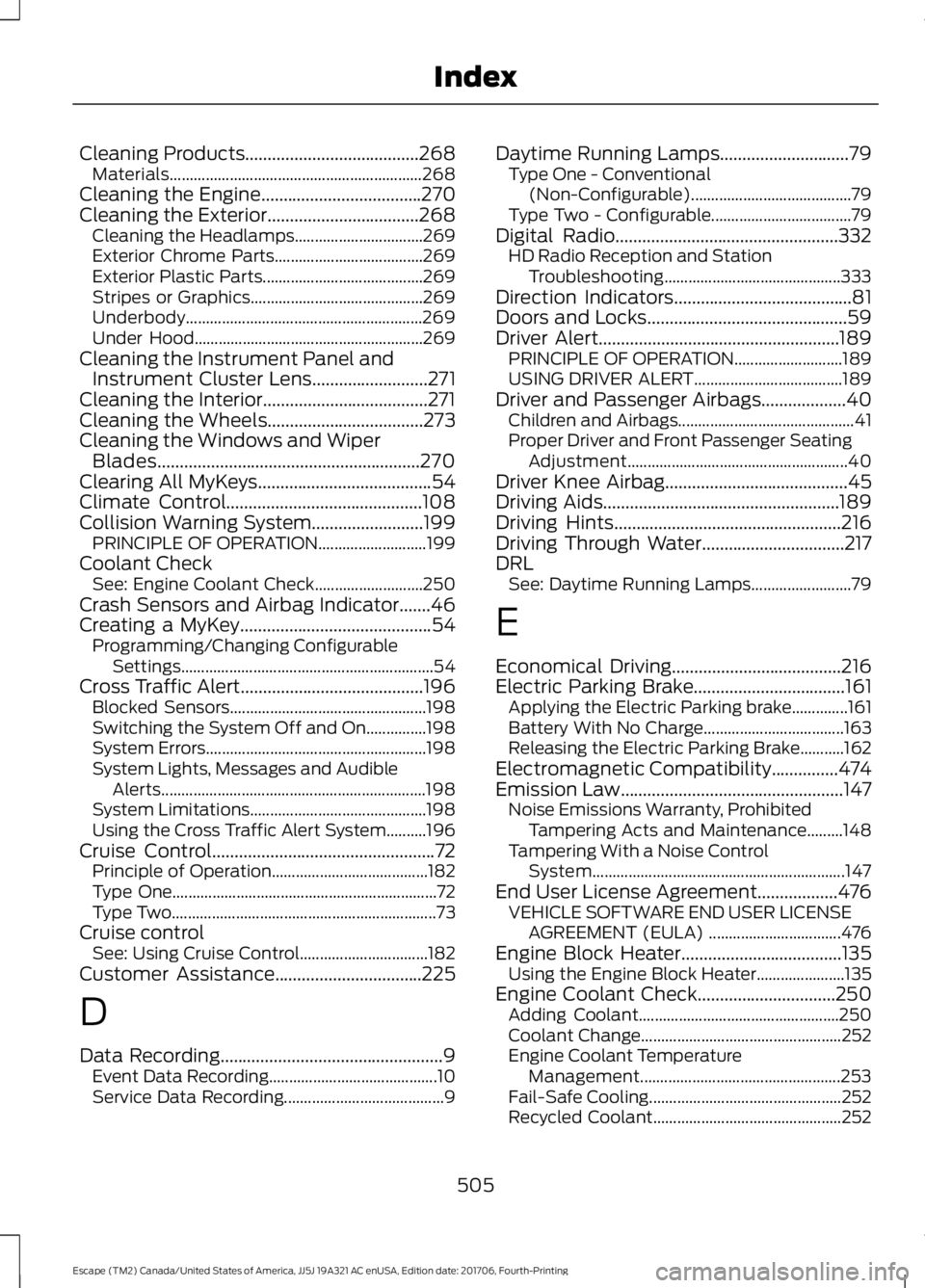
Cleaning Products.......................................268
Materials............................................................... 268
Cleaning the Engine....................................270
Cleaning the Exterior..................................268 Cleaning the Headlamps................................ 269
Exterior Chrome Parts..................................... 269
Exterior Plastic Parts........................................ 269
Stripes or Graphics........................................... 269
Underbody........................................................... 269
Under Hood......................................................... 269
Cleaning the Instrument Panel and Instrument Cluster Lens..........................271
Cleaning the Interior.....................................271
Cleaning the Wheels
...................................273
Cleaning the Windows and Wiper Blades...........................................................270
Clearing All MyKeys
.......................................54
Climate Control............................................108
Collision Warning System.........................199 PRINCIPLE OF OPERATION........................... 199
Coolant Check See: Engine Coolant Check........................... 250
Crash Sensors and Airbag Indicator.......46
Creating a MyKey
...........................................54
Programming/Changing Configurable
Settings............................................................... 54
Cross Traffic Alert.........................................196 Blocked Sensors................................................. 198
Switching the System Off and On...............198
System Errors....................................................... 198
System Lights, Messages and Audible Alerts.................................................................. 198
System Limitations............................................ 198
Using the Cross Traffic Alert System..........196
Cruise Control
..................................................72
Principle of Operation....................................... 182
Type One.................................................................. 72
Type Two.................................................................. 73
Cruise control See: Using Cruise Control................................ 182
Customer Assistance.................................225
D
Data Recording
..................................................9
Event Data Recording.......................................... 10
Service Data Recording........................................ 9Daytime Running Lamps.............................79
Type One - Conventional
(Non-Configurable)........................................ 79
Type Two - Configurable................................... 79
Digital Radio..................................................332 HD Radio Reception and Station
Troubleshooting............................................ 333
Direction Indicators
........................................81
Doors and Locks.............................................59
Driver Alert......................................................189 PRINCIPLE OF OPERATION........................... 189
USING DRIVER ALERT..................................... 189
Driver and Passenger Airbags
...................40
Children and Airbags............................................ 41
Proper Driver and Front Passenger Seating Adjustment....................................................... 40
Driver Knee Airbag
.........................................45
Driving Aids.....................................................189
Driving Hints
...................................................216
Driving Through Water................................217
DRL See: Daytime Running Lamps......................... 79
E
Economical Driving
......................................216
Electric Parking Brake..................................161 Applying the Electric Parking brake..............161
Battery With No Charge................................... 163
Releasing the Electric Parking Brake...........162
Electromagnetic Compatibility...............474
Emission Law
..................................................147
Noise Emissions Warranty, Prohibited
Tampering Acts and Maintenance.........148
Tampering With a Noise Control System............................................................... 147
End User License Agreement..................476 VEHICLE SOFTWARE END USER LICENSE
AGREEMENT (EULA) ................................. 476
Engine Block Heater....................................135 Using the Engine Block Heater...................... 135
Engine Coolant Check...............................250 Adding Coolant.................................................. 250
Coolant Change.................................................. 252
Engine Coolant Temperature Management.................................................. 253
Fail-Safe Cooling................................................ 252
Recycled Coolant............................................... 252
505
Escape (TM2) Canada/United States of America, JJ5J 19A321 AC enUSA, Edition date: 201706, Fourth-Printing Index